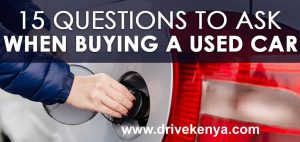
We all know that the four most commonly used diagnostic techniques in traditional African medicine are looking, smelling, asking, and feeling. In fact, these are also the basic skills we need to master when buying a used car in Kenya. By following these four points, you can choose a suitable used car.
First of all, we need to “look”. We need to look at the appearance of the car when buying a used car. We need to see if the overall condition of the car looks intact and if there are any dents or scratches. We also need to carefully inspect the tires and wheels to see if they are original. We need to pay attention to small details, such as whether there are missing parts or any malfunctions. Sometimes we may not be able to find any major issues with the car, but there may be minor issues that we can use to negotiate a lower price with the seller. It’s also important to observe the seller and see if they take good care of their car. The most important thing is to check the fuel tank to see if there are any leaks. This is easy to do by inspecting the screws on the fuel tank for any oil stains. If there are no oil stains, the tank is not leaking, but if there are stains, the tank is leaking.
Secondly, you should “smell” it. The main thing is to “smell” whether there is a strange smell in the exhaust after the car is started. Also, listen to see if there are any abnormal noises from the engine. This is very important because if the engine makes a lot of noise, then it’s not worth buying, as such an engine is very likely to break down. Moreover, the most expensive part of a car is the engine, so if something goes wrong with it, fixing it would be equivalent to buying another used car. It’s best to try the car out after the engine is started, check if the gear shift is smooth, test the steering wheel for any problems, and some people even smell inside the car to determine whether the owner took care of the car or not.
The third step is to “ask.” Everyone knows how to ask, but to get the information you want, you need to have some skills. Don’t ask meaningless questions such as whether the owner has done regular maintenance or oil changes. You need to be clever when asking questions. You can ask what the car is usually used for, how far the owner commutes to work, and how long the car is used every day. You can also chat with the owner and ask about the car’s advantages. Then, you can suddenly ask questions that you want to know, such as why the owner is selling the car or whether the car has had any problems in the past. You can also prepare some questions before buying a car to gather the information you need.
The fourth step is to “test drive.” Test driving means actually driving the car. As mentioned earlier, you need to check whether the car makes any noises or vibrations, whether the brakes and gears work well, and whether the engine is running smoothly. It’s best to test drive the car on a highway and drive at a speed of 70 miles per hour or above.
Finally, it’s worth noting that there are many unscrupulous dealers who sell scrap cars as used cars. In this case, you need to be particularly careful and consider what is wrong with the car. If the front of the car is damaged, there’s no point in considering it as these cars have likely been in serious accidents that could have damaged the engine. If the car has been damaged at the rear or sides, then it’s still worth considering, but you should inspect it carefully before making a purchase. Overall, it’s not recommended to buy a scrapped car.
In fact, buying a good second-hand car still depends on your own luck. If you are lucky, you can buy a good value. If you are not lucky, the car will fail after a long time. Problems are everywhere. When buying a second-hand car, it is best to consult with a mechanic for advice and learn a little professional knowledge.



